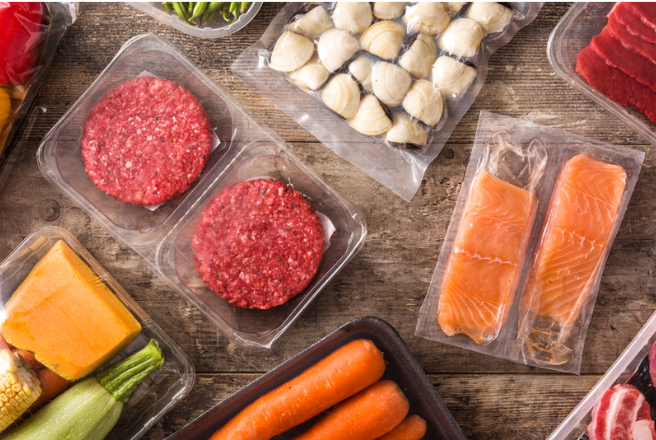A huge number of the foods we buy are contained in modified atmospheric packaging (MAP). Fruits, vegetables, meats and baked goods are all contained in a modified atmosphere to extend their shelf life. MAP means food tastes and looks fresher for longer, without any modification of the food itself.
Modified atmospheric packaging achieves this by replacing the air that would normally be trapped in the food container with an optimal blend of gases tailored to the foodstuff.1
The typical gas blends that are used in MAP are combinations of N2 and CO2, and for some food types O2 is also included. ‘Normal’ air has a composition of 78 % N2, 21 % O2 and 1 % argon alongside other trace gases.2 Of these gases, oxygen, is used the most carefully as it can react with the food, or provide the necessary conditions for the growth of microorganisms that lead to food spoilage.
MAP is widely used in the food industry as it offers a way of extending shelf life without the use of any chemical additives of preservatives. For products like salads, carefully selected MAP ensures that the product is desirable to consumers by remaining crisp and fresh at the point of sale.
The Best Conditions for Food Preservation: Modified Atmosphere Packaging

In order to maximise the preservative gains from MAP, the gas combination used is tailored to the foodstuff being packaged. For example, meats generally benefit from a MAP containing 70-80 % O2, whereas seafoods and shellfish usually benefit from low O2 levels and more CO2. The requirements for bulk shipping and the final individually packaged retail products also often differ, with the majority of bulk packaging requiring very high CO2 concentrations.3
The differences between the ideal gas compositions for meat and fish storage largely arise from the presence of myoglobin in the meat. Myoglobin, which is an iron-containing protein also present in human tissue, has a deep purple colour and can react with small gas molecules to form different complexes. If it reacts with O2, it forms oxymyoglobin, which has the bright red colour associated with fresh meats. However, if the oxymyoglobin or myoglobin is oxidised, it forms metmyoglobin, which is brownish in colour and is associated with food that has spoiled.4
Whether the O2 binding reaction or the oxidation process dominates is highly dependent on the oxygen concentration in the surrounding atmosphere. However, for most pre-cooked or non-meat products, an O2-free environment is advantageous. As a result, CO2 becomes the gas of choice. Carbon dioxides main role is to exclude oxygen from inside the packaging, which can result in the degradation of any foods (other than raw meat). At high concentrations CO2 can also act as an insecticide, preventing pests from attacking produce.
For cooked meats, CO2 concentrations of at least 30 % are required to preserve the meat for as long as possible. Fish, seafood, ready meals, vegetables and pastas also benefit from similar CO2 concentrations while harder cheeses and bakery products can benefit from CO2 concentrations of around 50 %.
For plant-based foods, being able to precisely determine the gas mixture for MAP conditions is particularly important. This is because some O2 helps the plant to respire but this needs to be balanced with an increased CO2 concentration to slow the rate of respiration and preserve the freshness for longer. However, excessive CO2 concentrations can also have a determinantal effect, so the concentrations need to be balanced exactly.
Guides available with recommendations for optimum MAP conditions for different products3, being able to create such environments relies on being able to accurately monitor and determine the concentrations of the different gases. Ideally, the gas sensors used for MAP need to be capable of real-time gas monitoring and analysis.
Sensors from Edinburgh Sensors for Modified Atmospheric Packaging
The Guardian and GasCard series of gas sensors from Edinburgh Sensors Guardian and GasCard series of real-time gas monitors excels, developed using nearly 40 years of expertise in gas sensor technologies. Both devices offer highly-accurate, high quality online gas sensing capabilities for the detection of CO2, ideally suited for bulk MAP requirements.
The Guardian series5 represents a complete, stand-alone gas monitor that uses infrared detection for the real-time monitoring of CO2 in conditions where concentrations range from 0 – 3000 ppm and 0 – 100 % volume. With an impressively quick 1.5 minute warm-up time, the sensor is designed with ease-of-use in mind, featuring an on-device display with set-up menus that can also be used for graphical display of historic readings over a user-defined period. As the sensor can operate in conditions of 0 – 95 % relative humidity and 0 – 45 °C, it is ideal for applications in MAP, particularly where CO2 concentrations are of primary interest.
Whilst the Guardian series are designed to be stand-alone sensors, Edinburgh Sensors also offers the GasCard range for use in applications where integration into another gas sensor device is required,.6 Also capable of real-time temperature and atmospheric pressure correction, the GasCard range offers detection sensitivities of 0 – 5000 ppm for CO2.
The GasCard uses RS232 communications to allow both control and real-time data logging and there is an option for on-board LAN support where required. It can operate under atmospheric conditions, and can also be customised for detection of additional gases or integrated with other gas sensing devices were greater versatility is required. All GasCards come with one-to-one customer service and technical support, including support for system integration.
References
- B. Ooraikul, Modified Atmosphere Packaging of Food, Springer, 1991
- Weather and Climate Basics, https://www.eo.ucar.edu/basics/wx_1_b_1.html, (accessed January 2018)
- Modified Atmospheric Packaging Poster, https://modifiedatmospherepackaging.com/~/media/Modifiedatmospherepackaging/Brochures/MAP-Poster-Guide-2014.ashx, (accessed January 2018)
- Meat Colouring Pigments, http://msue.anr.msu.edu/news/the_color_of_meat_depends_on_myoglobin_part_1, (accessed January 2018)
- The Guardian NG, https://edinburghsensors.com/products/gas-monitors/guardian-ng/, (accessed January 2018)
- The GasCard, https://edinburghsensors.com/products/oem/gascard-ng/, (accessed January 2018)

